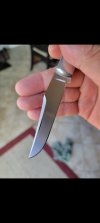Hello! I just recently got into knife making as a somewhat serious hobby after my day job. I have invested some amount of money in it (not crazy though) and have been trying my absolute hardest to complete at least 1 blade.
I recently have upgraded from a tiny 1 x 30 belt grinder to a 2 by 48 grinder from jet (The Jet IBGB-248, please let me know if that is an alright grinder for knife making. I am not making anything very large, so the work rest is enough for me for now).
My main question is, granted I have a 9-5 job and I am brand new to this (So far I have ruined bevels on 6 blades) what would be the best approach to grinding actual bevels. I have watched a decent amount of videos on YouTube about it and I am not sure if that is helping. I am aware this is a trial and error process but just through how many knives did you guys and should I expect to go through before I will successfully bevel one?
Also forgive me if this question somehow violates some posting rules, literally just registered an account so hopefully I am posting this at the correct board
I recently have upgraded from a tiny 1 x 30 belt grinder to a 2 by 48 grinder from jet (The Jet IBGB-248, please let me know if that is an alright grinder for knife making. I am not making anything very large, so the work rest is enough for me for now).
My main question is, granted I have a 9-5 job and I am brand new to this (So far I have ruined bevels on 6 blades) what would be the best approach to grinding actual bevels. I have watched a decent amount of videos on YouTube about it and I am not sure if that is helping. I am aware this is a trial and error process but just through how many knives did you guys and should I expect to go through before I will successfully bevel one?
Also forgive me if this question somehow violates some posting rules, literally just registered an account so hopefully I am posting this at the correct board



